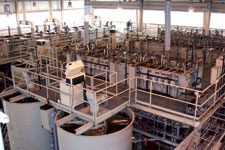Long Island Sounds small size, peculiar hydrology and proximity to New York City and growing urban and suburban centers in Connecticut and Long Island have long combined to pressure the quality of its water. Like elsewhere in the U.S., it rebounded quickly in the years following the implementation of the Federal Water Pollution Control Act of 1972. But increasing nitrogen levels traced to effluent discharged from the regions wastewater treatment plants slowly began choking the air and life from the 1,320-sq-mile water body. While Connecticut began targeting nitrate removal in 1998, New York City balked over a crippling $11-billion compliance estimate. Now, city officials are betting on recently developed Dutch technology to help cut those costs to less than $2 billion.  Click here to view maps
Click here to view maps
 Click here to view chart - The Dynamics of Hypoxia in Long Island Sound
Click here to view chart - The Dynamics of Hypoxia in Long Island Sound
In 2002, the city signed a consent order with state regulators to provide tertiary treatment by retrofitting five of its 14 plants with step-feed biological nitrogen removal (BNR) systems. Four plants discharging into the upper East River, including the 275-million-gallon-per-day Wards Island plant, and one discharging into environmentally sensitive Jamaica Bay already had added $50 million worth of improvements between 1996 and 2000. These included baffle walls in aeration tanks to create anoxic zones, submersible pumps to keep solids in suspension, froth controls and high-rate aeration diffusers. City records show that nitrogen discharge from the plants dropped from 95,000 lb per day to less than 73,000 lb. Reducing that to 48,000 lb per day may cost another $1.3 billion.  Click here to view chart
Click here to view chart
"The first plans for nitrogen removal relied on a traditional approach of adding extra tankage to a secondary treatment layout and extending retention time, which requires more aeration infrastructure and blowers," says Alfonso Lopez, New York City Dept. of Environmental Protection deputy director. "Even if the city had land available for adding tanks, which we dont, we were looking at $11 billion to $12 billion in costs. We had to find workable alternatives."
 |
| Split Stream. Routing effluent stream to different process chains can improve nitrogen removal efficiency. (Photo courtesy of Camp, Dresser and Mckee) |
Months after signing the upgrade agreement, city officials asked the New York State Dept. of Environmental Conservation to approve an amended plan with a more flexible approach, based on higher total suspended solids, less aeration infrastructure and a promising technology to treat sidestream centrate, the small-volume, nitrogen-rich waste stream produced during sludge dewatering. The centrate stream accounts for only 1% of the total flow in a plant but can contain up to 40% of the nitrogen load, according to the citys consulting engineer, Metcalf & Eddy, Wakefield, Mass. The SHARON system (single-reactor high-activity ammonia removal over nitrite) was developed at Delft University of Technology in the Netherlands during the 1990s. Adapting it to the BNR systems speeds process time without adding extra tanks or aeration equipment.  Click here to view chart
Click here to view chart
A 2-mgd SHARON system should achieve nitrogen removal rates similar to that of a standard 80-mgd advanced wastewater treatment plant, says M&E Senior Vice President Jim Anderson. The system improves on conventional four-step nitrification/denitrification by preventing the development of nitrates through temperature and pH control. It does not need a sludge settling and return pumping system, allowing it to be operated in a single process tank with a two-day retention time. That allows for a small plant footprint, critical to New Yorks constrained wastewater plant sites.
 |
| Think Tanks. New York City lab, built in 1988, has sponsored $50 million worth of research. (Photo by Guy Lawrence for ENR) |
New York Citys DEP has spent about $50 million on research at its P.O.-55 laboratory over the past decade. "Weve looked at 30 different process control configurations for nitrogen removal," says Lopez. Lab tests show that step-feed BNR process trains, with the SHARON process treating centrate sidestreams, will be effective. But the city also wants a three-year extension, to 2017, in order to complete construction.
Prove It.
Operators in Connecticut are bristling at the request and New York state regulators are not ready to sign off yet. In March, they issued the city a notice of violation for the current program for abandoning the original plan and asked for additional data on the amended proposal.
Long Island Sound has shown overall improvement over the past three decades, with some problematic areas, such as clarity and low dissolved oxygen, remaining in the bottom waters of its western reaches by New York City. In 1990, the Long Island Sound Study identified nitrogen loading as a leading cause of hypoxia and tertiary treatment seemed to be a costly but necessary solution (ENR 9/13/90 p. 13).
|
In 1998 Connecticut, New York and the U.S. Environmental Protection Agency signed a pact to cut nitrogen discharges into Long Island Sound by 58.5% from 1994 levels within 15 years. The strategy is in line with EPA goals to set total maximum daily load limits for certain pollutants. Nitrogen TMDLs are among the first. Detection and measurement is fairly simple and there is a wide and growing selection of treatment schemes available. New York Citys challenge is to bring discharge levels down from 15 to 20 mg/l to 7.5 mg/l now being achieved or exceeded at plants in Connecticut. In Florida, operators have been meeting nitrogen limits of 3 to 4 mg/l since the 1980s.
Connecticut attacked the problem with a nitrogen credit trading program. Regulators assigned nitrogen load targets for each of the 79 treatment plants in the watershed. Under the allocation formula, localities with shoreline plants, such as New Haven, Norwalk and Stamford, have higher multipliers than upriver facilities because their effluent is discharged directly into the sound. Similar to the federal clean air...

Post a comment to this article
Report Abusive Comment